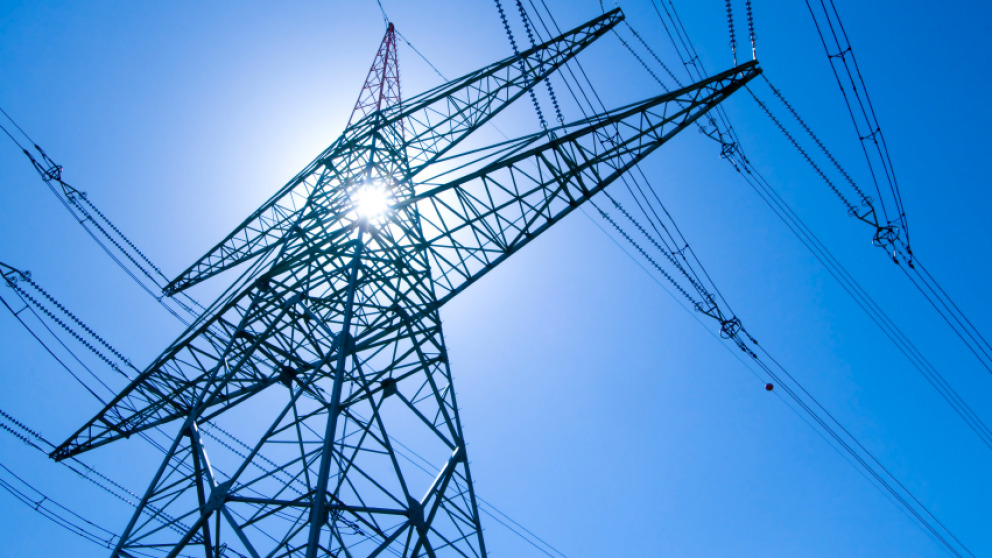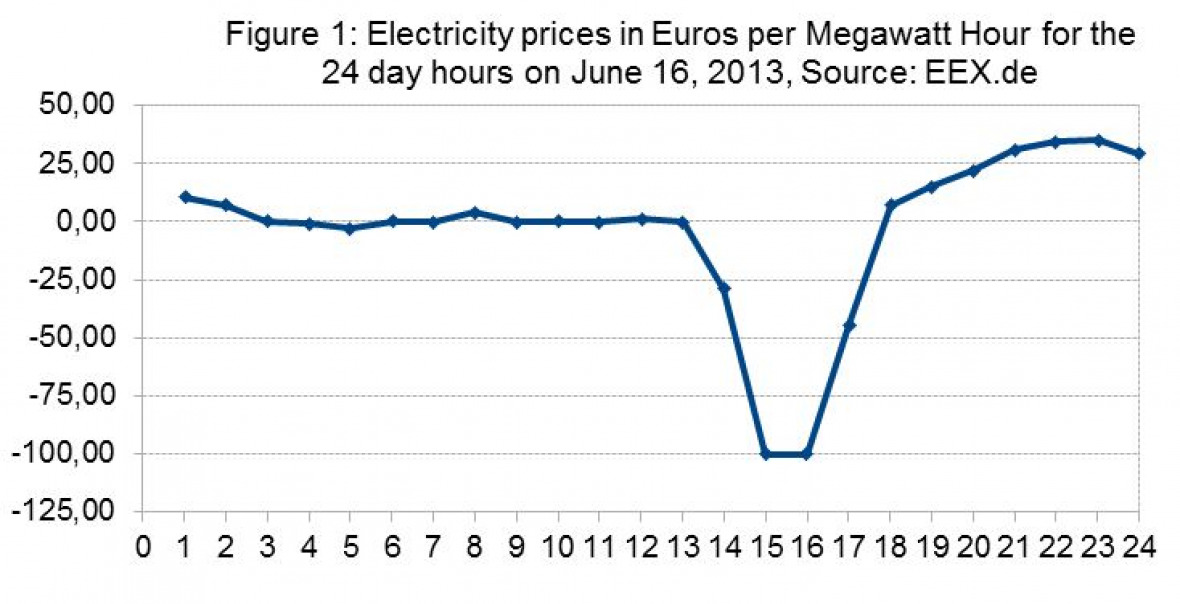Headline:
Electricity for free? Negative electricity prices and their consequences

On Sunday, June 16, 2013, electricity was traded virtually for free at the German power exchange. It was sold for about -3.33 Euros per Megawatt hour (MWh). What do negative prices actually mean? They mean that electricity generators have to pay a certain amount of money if they sell their electricity while consumers get extra money for their purchased electricity. The reason is an oversupply of electrical energy occurring during times of low demand. It is important to know that electricity in Germany is traded in products per hour. The price history on Sunday is illustrated below (Figure 1). It took an atypical course, i.e. the prices went from around 0.00 Euros during the morning via an extreme decline in the afternoon to positive prices only during evening hours. The extreme negative prices during Sunday afternoon of below -100.00 Euros per Megawatt hour resulted in a daily average price of about -3.33 Euros per Megawatt hour. In contrast, a typical price curve increases slightly during the day and decreases during evening hours in accordance with the demand curve.

What are the consequences of this development? Dr. Kathrin Goldammer, head of the Transdisciplinary Panel of Energy Change (TPEC) at the Institute for Advanced Sustainability Studies (IASS) in Potsdam, explains it more in detail. As a former power trader and asset optimizer, she has been observing the development of prices for electricity. She comments as such: “Very low or even negative prices for electricity are not a new phenomenon; however, during afternoon hours it is certainly uncommon. Prices for electricity incur on the basis of supply and demand. During times of low demand (e.g. on Sunday, June 16) and a high supply of solar and wind energy within the system, the result may be negative prices. Until recently, we were saw this phenomenon during night hours only. For conventional power plants operators such as coal or nuclear energy, negative prices can in fact be economically sound. This is to say that for such suppliers it is more efficient to keep their power plants running than shutting them down and reconnecting them more costly to the grid on Monday.”
If electricity producers want to avoid extra expenses during negative market prices, they have to keep their production flexible in order to be able to shut it off if necessary. As the weekend shows, market prices based on a high availability of energy generated by renewable resources are incentives for investments in the flexibility of conventional energy production. This is one crucial step for the further development of the energy system in the context of Germany’s Energiewende.
Even producers of renewable energy do not produce electricity at every market price constellation. In particular, direct suppliers selling their green energy on the market within the so called Marktprämienmodell get the price leveled up to the feed-in tariffs via market premiums and may also have an incentive to take out their capacities from the grid during times of very low negative prices. The reason is that they have to pay on top; but this occurs only in very exceptional constellations consisting of a high supply of solar and wind energy and a low demand for electricity at the same time. Such a constellation occurred on Sunday, June 16, 2013 for the first time and may occur again.
In consequence, professor Dr. Klaus Töpfer, the Executive Director of the IASS in Potsdam, calls for action: “Such price constellations are not new, but will be seen more often in the future. On the one hand, they demonstrate how effective the EEG law has fostered the expansion of renewable energies. On the other hand, it also shows the challenge how to integrate the increasing amount of variable cost-free production of renewables into the market. In order to move forward in this crucial development, we aim to present reasonable solutions for a solid and sustainable market system integration for the renewables.”
The Transdisciplinary Panel for Energy Change (TPEC) currently develops such a market system which fosters both the market integration and the socially responsible promotion of renewable energies. In fact, it entails a reform of the EEG law that does not stop the on-going development of renewable energy and enables a fair distribution of benefits.
However, there is no need to panic. Dr. Kathrin Goldammer resumes what she hears from contacts in the energy industry: “The constellation on Sunday has indeed been special. We have a highly connected system within Europe, and even in France there has recently been an unusually high availability of electricity. The average price on Sunday in France was around -40.99 Euros per Megawatt Hour. Due to the technical interconnection of our systems, the cheap amounts of electricity urge back to the German market and decrease the prices here even further.”
What about the private consumer? Short-term price fluctuations do not have any consequences for the electricity prices of final consumers. Private consumers pay an electricity price that is determined by less than one fifth by wholesale market prices. The rest of the price consists of network charges, taxes and allocations regulated by national law. However, there might be noticeable changes in the long run: If wholesale market prices continuously decrease, the portfolio price for supplier companies gets reduced as well. But the other share of costs has increased over the years; therefore, that latter development tends to be a more marginal factor. However, industrial large-scale consumers who are partially exempt from tax and deduction payments are more affected by fluctuating prices on the market. For them, negative prices are incentives for flexibilization. If they postpone their production to times of lower or negative prices, they decrease their average prices for electricity consumption. In a nutshell, negative market prices have consequences both on the side of supply and demand – and are therefore driving forces for changes of the energy system.
